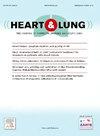慢性心肺疾病患者自我报告的症状轨迹
IF 2.6
4区 医学
Q2 CARDIAC & CARDIOVASCULAR SYSTEMS
引用次数: 0
摘要
背景慢性阻塞性肺疾病(COPD)或心力衰竭患者可能会经历类似的症状经历。然而,目前尚不清楚自我报告的症状轨迹是如何在恶化状态后发展的,特别是考虑到存在潜在的伴随疾病时。目的:在COPD或心力衰竭急性加重需要住院治疗后的两个月恢复期内,确定自我报告的症状轨迹的合理数量。方法对155名受试者进行纵向前瞻性队列研究。患者在ED出现24小时内因任一疾病加重或失代偿被纳入研究。在入院、出院以及出院后1个月和2个月后对症状进行评估。生长混合模型用于纵向识别症状轨迹。结果线性双轨迹解显示了最合适的模型拟合,表明总体总体症状负担轨迹为低和中等,在采样的两个月恢复期间,两者均呈纵向下降趋势。结论:识别这些轨迹使临床医生能够根据他们报告的症状负担,在疾病加重或失代偿后恢复的关键时期,确定哪些人可能受益于有针对性的服务。本文章由计算机程序翻译,如有差异,请以英文原文为准。
Self-reported symptom trajectories among chronic cardiopulmonary disease
Background
Individuals living with Chronic Obstructive Pulmonary Disease (COPD) or Heart Failure may experience similar symptom experiences. However, it remains unclear how self-reported symptom trajectories develop following exacerbation states, particularly when considering the potential for the existence of concomitant disease.
Objectives
To identify a plausible number of self-reported symptom trajectories over a two-month recovery period following acute exacerbation requiring hospitalization of either or both COPD or Heart Failure.
Methods
A longitudinal prospective cohort study of 155 participants was conducted. Persons were enrolled in the study within 24 h of ED presentation for exacerbation or decompensation of either disease. Symptoms were assessed upon admission, discharge, and after 1- and 2-months post-discharge. Growth mixture modeling was employed to identify symptom trajectories longitudinally.
Results
A linear, two trajectory solution demonstrated the most appropriate model fit, which illustrated the presence of a low overall and moderate overall symptom burden trajectory, each decreasing longitudinally over the sampled two-month period of recovery.
Conclusion
Identifying these trajectories allows clinicians to identify those who may benefit from targeted services based on their reported symptom burden during this critical period of recovery following exacerbation or decompensation of either disease.
求助全文
通过发布文献求助,成功后即可免费获取论文全文。
去求助
来源期刊

Heart & Lung
医学-呼吸系统
CiteScore
4.60
自引率
3.60%
发文量
184
审稿时长
35 days
期刊介绍:
Heart & Lung: The Journal of Cardiopulmonary and Acute Care, the official publication of The American Association of Heart Failure Nurses, presents original, peer-reviewed articles on techniques, advances, investigations, and observations related to the care of patients with acute and critical illness and patients with chronic cardiac or pulmonary disorders.
The Journal''s acute care articles focus on the care of hospitalized patients, including those in the critical and acute care settings. Because most patients who are hospitalized in acute and critical care settings have chronic conditions, we are also interested in the chronically critically ill, the care of patients with chronic cardiopulmonary disorders, their rehabilitation, and disease prevention. The Journal''s heart failure articles focus on all aspects of the care of patients with this condition. Manuscripts that are relevant to populations across the human lifespan are welcome.
 求助内容:
求助内容: 应助结果提醒方式:
应助结果提醒方式:


